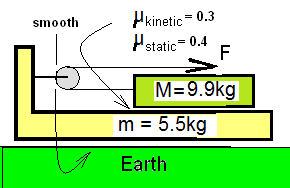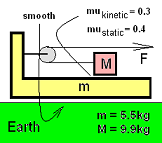| THERMO Spoken Here! ~ J. Pohl © ( A9841) | ( A9842 - Kinematics of Bar AB) |
Mass and Sled

The sketch (right) is from a physics text. According to the drawing, there is one horizontal force that acts with magnitude, F, directed to the right. The implication is acceleration of masses m and M occurs "at the very instance" of observation.
Calculate: The greatest force such that NO sliding of the mass on the sled will occur.
♦ For the event, since the sled and mass have no relative motion, the Second Law is written the masses taken together, (m + M). The force is the single entity having magnitude |F| and direction as I:

| (1)The direction of force is known. We take the dot product of the equation with "I". The unknown terms are: “F” and “d²X/dt²”. |
In Eqn (1) the acceleration is not known and the force magnitude is not known. The event occurs in the "X"-direction so the Second Law yields only one equation. Therefore we one equation and two unknowns ~ insufficient information to solve. We must analyze a smaller system.
For the condition of "no sliding," the acceleration of the mass M is the same as the sled m. Thus the Second Law for the mass M alone is:

| (2)The unknown terms are: “F” and “d²X/dt²”. |
In Equation (2), the friction force is written as f. It is common for the friction force to have values less than its maximum during an event. The maximum value of the friction force is written to the right in Equation (2)
The maximum force to the right is associated with the maximum friction force. Equations (1) and (2) become:

| (3)The unknown terms are: “F” and “d²X/dt²”. |
When these equations are solved simultaneously, one obtains:

| (4)The unknown terms are: “F” and “d²X/dt²”. |
 ♦ Sometimes a question regarding a system with its dynamics "in progress," can be answered without any understanding whatsoever of the initiation of that "progress." Skilled persons can answer these questions. Whoever wrote this physics problem did not see the event get started.
♦ Sometimes a question regarding a system with its dynamics "in progress," can be answered without any understanding whatsoever of the initiation of that "progress." Skilled persons can answer these questions. Whoever wrote this physics problem did not see the event get started.
sled_Mass_2.png
In classical mechanics (some manner of) initiation can be prescribed. For beginners, to be able to construct how the event began (or might have begun) is helpful. The sketch is an "expanded version" of our "physics problem."
I show one possible "initial condition (above right). All matter of that "initial condition" has zero acceleration; everything moves at SOME constant velocity... the easiest constant velocity is ZERO velocity; everything is at rest relative to Earth. In this sketch I post pone addressing friction by representing it as a "shear pin."
Explanation (to be provided later) is missing.
For times of the event for the sled (m) and mass (M) have no inclination for relative motion), their accelerations are equal:
Mass and Sled
 The sketch is from a physics text. According to the drawing, there is one horizontal force that acts with magnitude, F, directed to the right. The implication is acceleration of masses m and M occurs "at the very instance" of observation.
The sketch is from a physics text. According to the drawing, there is one horizontal force that acts with magnitude, F, directed to the right. The implication is acceleration of masses m and M occurs "at the very instance" of observation.
Calculate: The greatest force such that NO sliding of the mass on the sled will occur.
Premise presently unwritted!